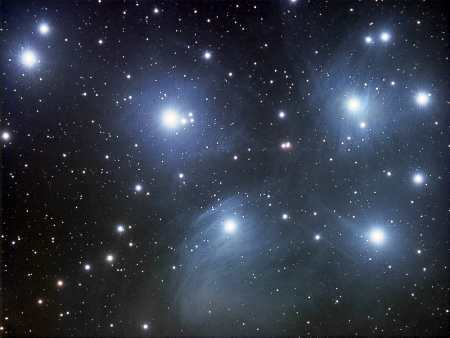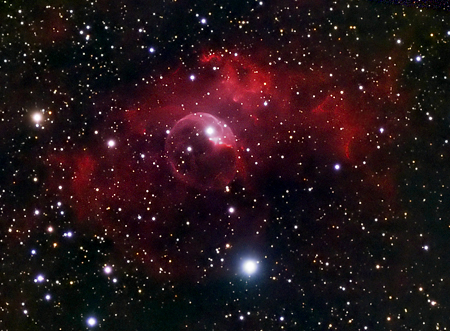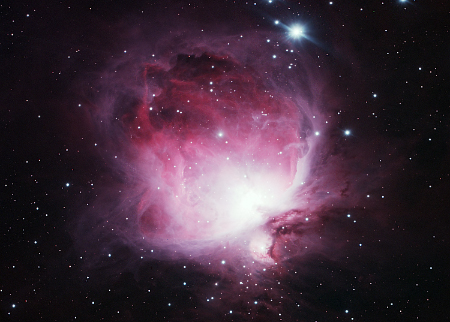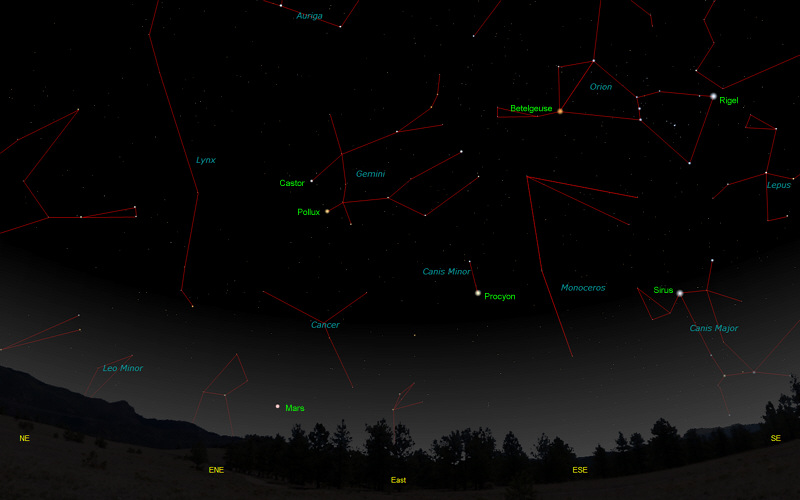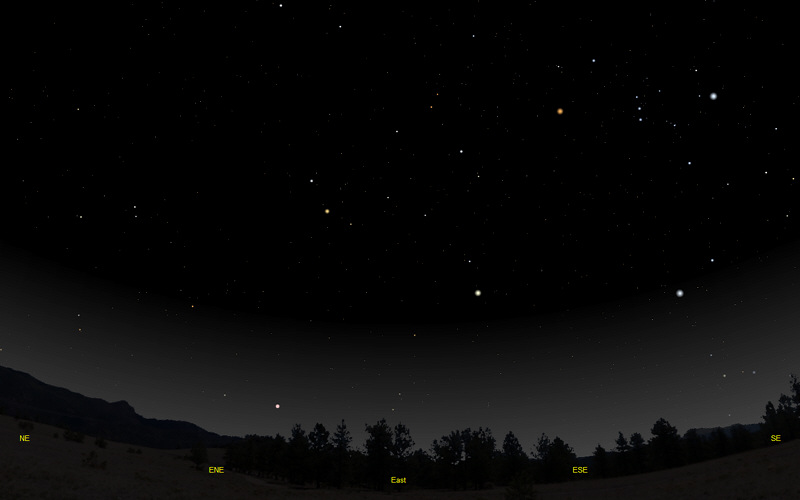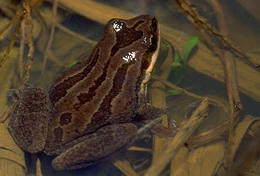The purpose of this feature is to give scout leaders, educators and naturalists an idea of some of the natural events coming up each month. We will try to cover a variety of natural events ranging from sky events to calling periods of amphibians, bird and mammal watching tips, prominent wildflowers and anything else that comes to mind. We will also note prominent constellations appearing over the eastern horizon at mid-evening each month for our area for those who would like to learn the constellations. If you have suggestions for other types of natural information you would like to see added to this calendar, let us know! Note: You can click on the hyperlinks to learn more about some of the featured items. To return to the Calendar, hit the "back" button on your browser, NOT the "back" button on the web page. All charts are available in a "printer friendly" mode, with black stars on a white background. Left clicking on each chart will take you to a printable black and white image. Please note that images on these pages are meant to be displayed at 100%. If your browser zooms into a higher magnification than that, the images may lose quality. Though we link book references to nationwide sources, we encourage you to support your local book store whenever possible.
Notes and Images From November 2009
In late September we photographed some of the wildlife around our front porch, including some colorful Spicebush Swallowtail caterpillars. Those images were included in the October Natural Calendar. Although one of the caterpillars formed a chrysalis beneath the overhang of our front porch roof, the chrysalis we photographed in September was attached to a Spicebush leaf. It seemed a risky venture, and we watched the chrysalis as the fall winds swept the leaves from the Spicebush surrounding our front porch. More than one time we thought the winds had swept the chrysalis away only to find that it so perfectly matched the few remaining dead leaves that we had overlooked it. By the end of the third week of November the Spicebush leaves had disappeared. All but one. The one leaf on which the caterpillar formed the chrysalis stubbornly remained, rocking back and forth in the wind.
This seemed like too much of a coincidence, so we looked closely at the petiole of the one remaining leaf. We found that the petiole of the leaf had indeed separated from the twig. But it was held tight by a web of silk that surrounded it and the bright green buds beside it. In the highly magnified view at left you can see the end of the petiole held firmly to the twig by the silk canopy. Although the Spicebush Swallowtail caterpillars deposit silk on the surface of leaves to make the leaf surface curl around them, we did not observe this caterpillar spinning the silk web around the end of the petiole. Since other species exhibit this behavior, it seems likely the Spicebush Swallowtail caterpillars do this as well. We will be looking for this next season. In the mean time, we hope the chrysalis makes it through the winter.
For many sky watchers the Pleiades is among the most memorable sights in the sky. In his autobiography, Starlight Nights, comet hunter Leslie Peltier told of seeing the Pleiades through his kitchen window when he was five years old. He was going to the kitchen for a glass of water. He wrote, "Now when one did this at night in a 1905 farm house one did not pause at the kitchen door and snap on a light switch. There was no light switch, for electricity was still twenty dark-years from the farm. So I just left the door wide open and, aided somewhat by the feeble glow that somehow managed to struggle through from the shadeless kerosene lamp in the dining room, I groped around until I located the water." Looking out a window of the darkened room, he noticed a little group of stars. When he pointed the cluster out to his mother, she told him it was the Pleiades. Peltier wrote, "This was my first meeting with the stars." The Pleiades is about 440 light-years from us, and the cluster stars share the same proper motion across the sky. The beautiful nebulosity which wreathes the brighter members of the Pleiades is not part of the cluster, but is a dust cloud that the cluster happens to be passing through. The dust shines by light reflected from the very hot and luminous cluster stars, which appear like searchlights in a fog. The strands of nebulosity, which can be better seen in the larger version of the image (click on the image above) also look remarkably like cirrus clouds in our own atmosphere. Although the cluster is small, not much larger than the full Moon, it has been known since antiquity and features prominently in the mythology of many cultures. In Greek mythology the stars represent seven sisters who were being pursued by Orion. Zeus rescued the maidens by transforming them into doves and placing them in the sky. In Japan, the cluster is known as Subaru. According to Robert Burnham, the midnight culmination of the Pleiades was an event of great importance in Aztec and Mayan tradition.1 In the middle ages the midnight culmination of the cluster became the traditional date of the Witch's Sabbath. The date is observed in modern times as All Hallows' Eve or Halloween, although due to the precession of the equinoxes the midnight culmination of the cluster is now on November 21st. There are many references to the cluster in literature. The 13th century Persian poet Sadi writes in the poem, "Gulistan" (rose garden), "The ground was if strewn with colored enamel, and necklaces of Pleiades seemed to hang upon the branches of the trees..." Look for the Pleiades almost directly overhead around 10:45pm on December 1st. The beautiful strands of nebulosity that surround the brighter members of the cluster are usually not visible in small telescopes. The nebulosity below Merope (the bright star below the center of the image above) is the easiest to pick out, but you will need a very clear moonless night for the task. As we said last month, this part of the nebulosity was discovered by Tempel, who described this faint nebulosity as looking like "a breath on a mirror".
A star also illuminates the Bubble Nebula, NGC 7635. In this case the star is the Wolf-Rayet star SAO 20575. In the image at left, it is the brightest star within the "bubble." This star is about 20 times more massive than our Sun, and has a surface temperature exceeding 25,000 degrees K. The surface of our Sun is about 5,800 degrees K. The intense radiation from this star causes the gas around it to glow. Nebulae like the Bubble Nebula are called emission nebulae. If you look closely at the larger version of the image (click on the image at left) you can see how the radiation from the Wolf-Rayet star is sculpting the gas in the nebula, and fingers of gas point back toward this star. Wolf-Rayet stars are relatively short-lived and end their lives violently, exploding as supernovas. The Bubble Nebula is located in western Cassiopeia, and is much farther away than the Pleiades. Current estimates place its distance at 11,000 light-years. In order to give some sense of scale, note that if one placed the Sun at the center of the bubble, Alpha Centauri, the nearest star to the Sun, would still be within the bubble.
Sky Events for December 2009: The Winter Solstice, marking the beginning of winter in the Northern Hemisphere, occurs at 11:47am CST on December 21st. The Geminid Meteor Shower peaks on the evening of December 13th and the morning of December 14th. Look near the bright star Castor in Gemini (see the star chart below). This should be a good year for the Geminids. Evening Sky: Look for bright Jupiter to the southwest shortly after dusk. This is a good opportunity to explore the giant planet with a telescope. You can usually pick out up to four bright moons with binoculars, provided you steady them against something solid. Mercury skims the southwestern horizon at dusk from December 12th through the 26th. Look for it about 6 degrees above the horizon. A good time to begin searching is about 30 minutes after sunset. Binoculars will improve your chances of finding the small planet, but use them only after the sun has set. Mars rises about 9:30pm CST in Leo at the beginning of the month. The red planet is growing brighter as Earth and Mars approach each other. The closest approach will occur on January 29th, 2010. Morning Sky: Saturn rises about 12:24am at mid-month in Virgo. All times noted in the Sky Events are for Franklin, Tennessee and are Central Standard Time. These times should be pretty close anywhere in the mid-state area. Constellations: The views below show the sky looking east at 9:30pm CST on December15th. The first view shows the sky with the constellations outlined and names depicted. Star and planet names are in green. Constellation names are in blue. The second view shows the same scene without labels. Look for the bright stars Castor and Pollux in the constellation of Gemini, The Twins. Compare the colors of the bright stars Betelgeuse and Rigel in Orion. Betelgeuse is a red giant and Rigel is a very hot, blue-white supergiant. If you have a telescope, point it to the center of the three "sword" stars below Orion's belt. There you will find the Orion Nebula, M42, one of the most magnificent emission nebulas in the sky. The pink glow of hydrogen alpha light is visible only in very large telescopes and the nebula appears as a small greenish glow in small telescopes. Crouching beneath the feet of Orion, is Lepus, the Hare. Sirius, the brightest star in the sky, shines below Orion. Sirius is in Canis Major, the Great Dog, and for that reason is known as the Dog Star. In the late summer, Sirius rises at the same time as the sun. Because of this, these late summer days are known as “the dog days." The faint constellation Monoceros, the Unicorn, follows Orion over the eastern horizon. Low in the eastern sky below Gemini is Canis Minor, with its bright star Procyon. Procyon means, "before the dog," and refers to the fact that Procyon rises just before the Dog Star, Sirus. Look below Gemini and see if you can spot the faint glow of M44, the "Beehive Cluster." This cluster is located in Cancer, the Crab. Finally, look just above the eastern horizon to see bright Mars rising, glowing like a hot coal. Mars is getting quite bright now as it and the Earth draw near. The Earth will swing by Mars in January, 2010.
On Learning the Constellations: We advise learning a few constellations each month, and then following them through the seasons. Once you associate a particular constellation coming over the eastern horizon at a certain time of year, you may start thinking about it like an old friend, looking forward to its arrival each season. The stars in the evening scene above, for instance, will always be in the same place relative to the horizon at the same time and date each December. Of course, the planets do move slowly through the constellations, but with practice you will learn to identify them from their appearance. In particular, learn the brightest stars (like Sirius and Procyon in the above scene), for they will guide you to the fainter stars. Once you can locate the more prominent constellations, you can "branch out" to other constellations around them. It may take you a little while to get a sense of scale, to translate what you see on the computer screen or what you see on the page of a book to what you see in the sky. Look for patterns, like the three stars in a line in Orion's belt. The earth's rotation causes the constellations to appear to move across the sky just as the sun and the moon appear to do. If you go outside earlier than the time shown on the charts, the constellations will be lower to the eastern horizon. If you observe later, they will have climbed higher. As each season progresses, the earth's motion around the sun causes the constellations to appear a little farther towards the west each night for any given time of night. If you want to see where the constellations in the above figures will be on January 15th at 9:30pm CST, you can stay up till 11:30pm CST on the December 15th and get a preview. The westward motion of the constellations is equivalent to two hours per month. For instance, if you want to see what stars will be on your eastern horizon on March 15th at 9:30pm CST (3 months later), you would need to get up at 3:30am CST in the morning on December 15th (3 months times 2 hours/month = 6 hours).
Recommended: Sky & Telescope's Pocket Star Atlas is beautiful, compact star atlas. It is destined to become a classic, and is a joy to use at the telescope. Leslie Peltier's autobiography, Starlight Nights, offers a glimpse of what it was like to grow up on a farm in the early 1900's. Peltier was a comet hunter and his descriptions of the night sky are beautiful. A good book to learn the constellations is Patterns in the Sky, by Hewitt-White. You may also want to check out at H. A. Rey's classic, The Stars, A New Way to See Them. For skywatching tips, an inexpensive good guide is Secrets of Stargazing, by Becky Ramotowski. A good general reference book on astronomy is the Peterson
Field Guide,
A Field Guide to the Stars and Planets, by Pasachoff. The book retails for around $14.00. Starry Night has several software programs for learning the night sky. Visit the Starry Night web site at www.starrynight.com for details.
Amphibians:
December really marks the beginning of the breeding season for our Tennessee frogs and toads. We have had breeding choruses of Upland Chorus Frogs as early as December 4th. Breeding even before Wood Frogs, these irrepressible inhabitants of flooded winter fields and other wet areas will call throughout the cold winter months. Listen for their call, which sounds like someone dragging their thumb across the teeth of a plastic comb, on mild wet winter evenings. Listen also for Southern Leopard Frogs. We hear them throughout the fall. Many other Tennessee frogs and toads can also be seen on mild December nights, but most are silent. Recommended: The Frogs and Toads of North America, Lang Elliott, Houghton Mifflin Co.
Archives (Remember to use the back button on your browser, NOT the back button on the web page!) Natural Calendar November 2009 Natural Calendar September 2009 Natural Calendar February 2009 Natural Calendar December 2008 Natural Calendar November 2008 Natural Calendar September 2008 Natural Calendar February 2008 Natural Calendar December 2007 Natural Calendar November 2007 Natural Calendar September 2007 Natural Calendar February 2007 Natural Calendar December 2006 Natural Calendar November 2006 Natural Calendar September 2006 Natural Calendar February 2006
Natural Calendar
December 2005
Natural Calendar
November 2005
Natural Calendar
September 2005
Natural Calendar
February 2005
Natural Calendar
December 2004
Natural Calendar
November 2004
Natural Calendar
September 2004
Natural Calendar
February 2004
Natural Calendar
December 2003
Natural Calendar
November 2003
Natural Calendar
September 2003 Natural Calendar February 2003 Natural Calendar December 2002 Natural Calendar November 2002 Nature Notes Archives: Nature Notes was a page we published in 2001 and 2002 containing our observations about everything from the northern lights display of November 2001 to frog and salamander egg masses. 1 Burnham's Celestial Handbook, Robert Burnham, Jr. (Three Volumes), Dover Press Night scenes prepared with The Sky Professional from Software Bisque All images and recordings © 2009 Leaps |
|||||||||||


